
Goats in the Sailor's Diet: 1 2 3 4 Next>>
Goats in Sailor's Diets During the Golden Age of Piracy, Page 2
Goats as Food: Caribbean Islands
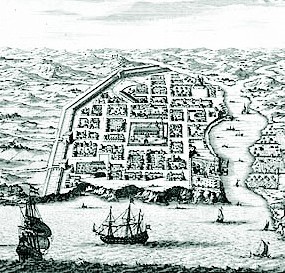
Artist: Arnoldus Montanus
San Domingo, Hispaniola, From De Nieuwe en
Onbekende Weereld (1671)
Curiously, the primary locale most people associate with the golden age of pirates, the Caribbean, hasn't much to say about the availability of goats. In telling the history of pirate captain Charles Vane, author Charles Johnson reveals a bit about the character of Hispaniola and goats, explaining that Vane's pirates lived "riotously on board, having an abundance of liquor, and plenty of fresh provisions, such as hogs, goats, sheep, and fowl, which he got upon easy terms"1.
The other description of goats on a Caribbean Island from this period is for Tortola in the British Virgin Islands. While there in 1683, William Cowley "digged three Wells, in order to get fresh Water to water our Ship, and traded with the Inhabitants for Goats and Fruit"2. He also landed on Salt Island, a small, rather desolate spit of land off of Tortola "where we came to an Anchor: Here were no Fruits nor good fresh Water, but plenty of Fish, and the Land affordeth Goats, tho’ they are very small"3.
1 Captain Charles Johnson, The History of the Pirates, p. 223; 2 William Ambrosia Cowley, "Cowley’s Voyage Round the Globe" from William Hacke’s book A collection of original voyages, p. 2; 3 Ibid.
Goats as Food: Indian Ocean
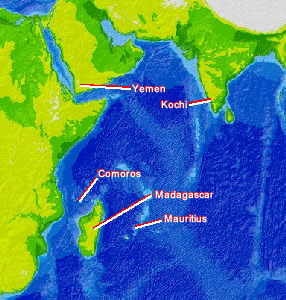
Indian Ocean with locations Discussed in Text
Goats were mentioned as food in several locations bordering the Indian Ocean. Although it might not be the first place that comes to mind when discussing pirates, they were quite active in certain locations here. Pirate captain John Bowen "came to an anchor about three leagues to the northward of Cochen [or 'Cochin' - now Kochi, India], expecting some boats to come off with supplies of refreshments, for which purpose they fired several guns, by way of signal, but none appearing, the quarter-master was sent in the pinnace to confer with the people, which he did with some caution, keeping the boat upon their oars at the shore side. In short, they agreed very well, the pirates were promised whatever necessaries they wanted, and the boat returned aboard.
The next day a boat came off from the town with hogs, goats, wine, &c [etc.]"1.
Of course, the real hotbed of piracy during the golden age of pirates in the Indian Ocean was another place - one that appears to have been well stocked with goats.
Goats as Food: Indian Ocean - Madagascar and Surrounding Islands -
Merchant captain Alexander Hamilton (no, not that one) explained that the island had "Goats and Deer plenty enough, and when the Portugueze first sailed along the Coasts of this Island, they left a Brood of Hogs, that has mightily increased.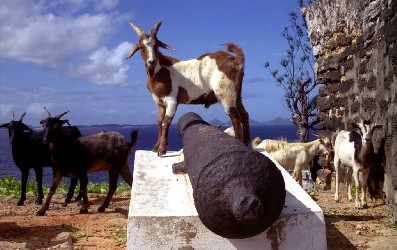
Photographer: Ken Walker
See, this is what happens when goats hang around with pirates.
Goat at Fort Dauphin, Madagascar
"2 The lush conditions of the island allowed for a proliferation of plant and animal life. In fact, according to wikipedia, the island "is a biodiversity hotspot; over 90 percent of its wildlife is found nowhere else on Earth."3 Charles Johnson pauses in his narrative on pirate captain Edward England to explain that Madagascar supplied "Provisions of all Sorts, Oxen, Goats, Sheep, Poultry, Fish, Citrons, Oranges, Tamarinds, Dates, Coco-Nuts, Bananas, Wax, Honey, Rice, or in short, Cotton, Indigo, or any other Thing they will take Pains to plant, and have Understanding to manage."4
Madagascar was also a favorite hangout for pirates during the golden age of piracy. As Hamilton explained during the period, the rivers primarily served as "Nests to Pirates."5 And why not? There were plenty of merchant ships plying the waters of the Indian ocean laden with jewels, silks and spices. There were also a number of places in the area for the pirates to sell their plunder. On top of all that, the natives of Madagascar were (at least at times) friendly to the pirates and the land provided most of what they needed as has already been mentioned.
There were also goats to be found on the islands surrounding 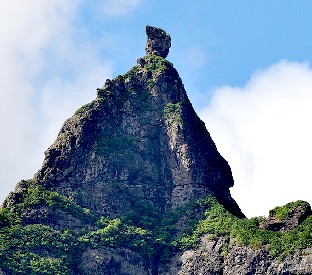
Photographer: Hansueli Krapf
Goat-friendly Pieter Both Mountain-top, Mauritius Madagascar. To the west was the island of Mauritis which seems to have been a convenient supply port to sea travelers. Seaman Edward Barlow explains that in 1689 the island "aboundeth with store of good fresh provisions, only it wants bread corn. Here is store of good wild deer and wild goats and hogs, and sea and land turtles or tortoises, and plenty of fresh good fish."6 That's pretty high praise coming from Barlow, who can always find something wrong (like a lack of bread corn.) In the account of pirate captain Nathaniel North, we are told that the crew "stopped at Don Mascarenhas [Mauritis], where they took in a quantity of hogs, goats, sheep, fowls of all sorts, and green turtle."7
To the east were the Comoros Island, which included the island of Joanna [modern day Anjouan] which appears to have been a similarly useful place of ship refreshment. Hamilton informs his reader that it "is a plentiful Island in Cattle, Goats, Fowls and Fish, with good Lemons and Oranges, so that most Part of the English Shipping bound to Mocha and Surat, usually called there for Refreshments, till the Pirates began to frequent it."8 Indeed, Johnson tells us that John Halseys pirates "touched at Johanna, and there took in a quantity of goats and cocoa nuts for fresh provisions" on their way to the Straits of Bab-el-Mandeb.9
Goats as Food: Indian Ocean - Yemen
Yemen is a rather curious Arabian country that is arid. Yet it also receives the most rainfall in Arabia. Wikipedia tells us that, "Despite the aridity, the presence of many lagoons makes this region very marshy and a suitable breeding ground for malaria mosquitoes."10 Amazingly, this did not entice the pirates, at least not according to Charles Johnson. They appear not to have bothered with this nation. However, 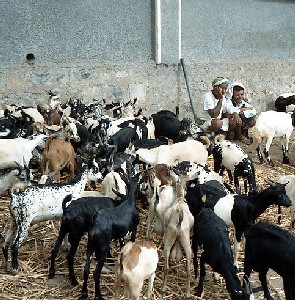
Photographer: Bernard Gagnon
"I suppose you're wondering why I called you all here..."
Goats in a Yemeni market in Bayt al-Faqih
several seamen did make landfall here, probably because it was well located for trading, being on an important sea-route between India and Europe.11 The city of Mocha was, not surprisingly, a well-known location for purchasing coffee. (It is in the part of the country that receives all the rainfall mentioned earlier.)
While in Mocha, merchant captain Edward Barlow explains that the merchants had "good plenty of provisions, very good beef, mutton and 'caberto' [goat's meat], plenty of fowls but no hogs, being of the Mahometan race."10 Captain Alexander Hamilton found a similar situation in Mocha, stating that the merchants were "well stored with animal Provisions, such as Beef [!], Mutton of Sheep and Goats, Lamb and Kid, Camel and Antelopes Flesh, Dung-hill Fowls, Guinea Hens, Partridge and Pigeon."12 So there was plenty of meat to be had with your coffee.
Francis Rogers gives us another example of Yemeni goat's meat being available for purchase while he was in port at Aden in 1702. He explains that "[e]ating would be very cheap were it but good... [except the merchants] being obliged to bring their goats and sheep and all other provision a great way, are used to give about 5 or 6 Arafs for a good likely goat and 7 or 8 for a sheep, and other provisions accordingly."13 Not being able to discover what an 'Araf' was worth (or even what it was), I can only guess that this is expensive based on Rogers' comment.
1 Captain Charles Johnson, The History of the Pirates, p. 55; 2 Alexander Hamilton, British sea-captain Alexander Hamilton's A new account of the East Indies, 17th-18th century, p. 27; 3 Madagascar, wikipedia, gathered 4/4/13; 4 Captain Charles Johnson, A general history of the pirates, 3rd Edition, p. 135; 5 Hamilton, ibid.; 6 Edward Barlow, Barlow’s Journal of his Life at Sea in King’s Ships, East and West Indiamen & Other Merchantman From 1659 to 1703, p. 402; 7 Johnson, History, p. 200; 5 Hamilton, ibid.; 7 Johnson, History, p. 99;10 Yemen, wikipedia, gathered 4/5/13; 11 Anna Hestler & Jo-ann Spilling, Yemen, p. 136; 12 Barlow, p. 481; 5 Hamilton, p. 52; 13 Francis Rogers. from Bruce S. Ingram's book Three Sea Journals of stuart times, 1936, p. 168

